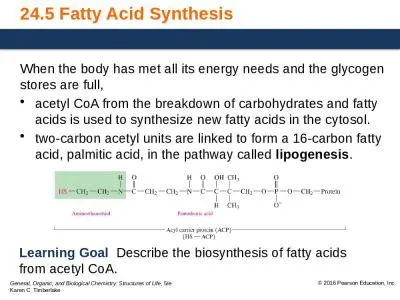

When the body has met all its energy needs and the glycogen stores are full acetyl CoA from the breakdown of carbohydrates and fatty acids is used to synthesize new fatty acids in the cytosol twocarbon acetyl units are linked to form a 16carbon fatty acid ID: 909512
Download Presentation The PPT/PDF document "24.5 Fatty Acid Synthesis" is the property of its rightful owner. Permission is granted to download and print the materials on this web site for personal, non-commercial use only, and to display it on your personal computer provided you do not modify the materials and that you retain all copyright notices contained in the materials. By downloading content from our website, you accept the terms of this agreement.
Slide1
24.5 Fatty Acid Synthesis
When the body has met all its energy needs and the glycogen stores are full, acetyl CoA from the breakdown of carbohydrates and fatty acids is used to synthesize new fatty acids in the cytosol.two-carbon acetyl units are linked to form a 16-carbon fatty acid, palmitic acid, in the pathway called lipogenesis.
Learning Goal Describe the biosynthesis of fatty acids from acetyl CoA.
Slide2Lipogenesis: Fatty Acid Synthesis
The synthesis of fatty acids proceeds in a separate pathway, with different enzymes; it is not a simple reversal of fatty acid oxidation. occurs in the cytosol using the reduced coenzyme NADPH instead of occurring in the mitochondria, where oxidation takes place using FAD and NAD+.
The reduced coenzyme NADPH is similar to that of NADH, with a phosphate group.
Slide3Synthesis, Acyl Carrier Protein, ACP
In fatty acid synthesis,an acyl carrier protein
(HS — ACP) activates the acyl
compounds.
HS — ACP contains the
thiol
and pantothenic acid
(vitamin B5) groups found in acetyl CoA attached to a protein.
Slide4Preparation of Activated Carriers
Before fatty acid synthesis can begin, the activated carriers must be synthesized.The synthesis of a three-carbon malonyl ACP requires the synthesis of malonyl CoA, when acetyl CoA combines with bicarbonate.the hydrolysis of ATP, which provides the energy for the reaction.
Slide5Preparation of Activated Carriers
The activated forms of malonyl ACP and acetyl ACP are produced when the acyl group is combined with HS — ACP.
Slide6Synthesis of Fatty Acids: Reaction 1
The synthesis of a fatty acid occurs in the cytosol and requires a cycle of four reactions: In reaction 1, condensation,3-ketoacyl ACP synthase catalyzes the condensation of acetyl ACP and malonyl
ACP. a four-carbon acetoacetyl ACP and CO2 are produced.
Slide7Synthesis of Fatty Acids: Reaction 2
In reaction 2, reduction,3-ketoacyl ACP reductase reduces the 3-keto group using 2H from NADPH + H+
.3-hydroxyacyl ACP, an alcohol, and the oxidized coenzyme NADP+ are produced.In the cytosol, NADPH is used to provide hydrogen for reduction reactions.
Slide8Synthesis of Fatty Acids: Reaction 3
In reaction 3, dehydration,3-hydroxyacyl ACP dehydrase catalyzes the dehydration of the hydroxyl. a trans double bond in trans-2-enoyl ACP is formed.
Slide9Synthesis of Fatty Acids: Reaction 4
In reaction 4, reduction,enoyl ACP reductase uses hydrogen from NADPH + H+ to reduce the double bond to a single bond.
butyryl ACP, a saturated four-carbon compound, two carbon atoms longer than the original acetyl ACP, forms.
Slide10Fatty Acid Synthesis, Cycle Repeats
The cycle of fatty acid synthesis repeats asmalonyl-ACP combines with the four-carbon butyryl
-ACP to form six-carbon hexanoyl-ACP.
C
16
palmitoyl
ACP, is hydrolyzed to yield palmitate and HS — ACP after seven cycles. The overall equation for the synthesis of palmitate from acetyl CoA is written as follows:
Slide11Longer and Shorter Fatty Acids
Palmitate is the first fatty acid produced by fatty acid synthesis. However, shorter fatty acids are released earlier in the fatty acid synthesis process before there are 16 carbon atoms in the
chain.longer fatty acids are produced with special enzymes that add two-carbon acetyl units to the carboxyl end of the fatty acid chain.
Slide12Regulation of Fatty Acid Synthesis
Fatty acid synthesis occurs in the adipose tissue and is stimulated by insulin. When blood glucose is high, insulin moves glucose into the cells, stimulating glycolysis and the oxidation of pyruvate.produces acetyl CoA for fatty acid synthesis.Two carbons are added to the growing fatty acid chain by using three-carbon
malonyl units. The transport of acyl groups into the matrix of the mitochondria is blocked, preventing their oxidation.
Slide13Summary of Lipogenesis
In fatty acid synthesis (lipogenesis2), two-carbon units
from acetyl CoA are added together to form palmitate.
Slide14Comparing β
Oxidation and Fatty Acid Synthesis
Slide15Study Check
Match each with the description below.1) Mitochondria 2)
cytosol 3) glucagon 4)
Insulin
5)
acetyl
ACP
6) malonyl ACPA. site of fatty acid synthesisB. site of β oxidation
C. starting material for
lipogenesis
D. compound added to elongate acyl-ACP
E. activates
β
oxidation
F. activates
lipogenesis
Slide16Solution
Match each with the description below.1) Mitochondria 2)
cytosol 3) glucagon 4)
Insulin
5)
acetyl
ACP
6) malonyl ACPA. site of fatty acid synthesis B. site of β
oxidation
starting
material for
lipogenesis
D. compound added to elongate
acyl-ACP
E. activates
β
oxidation
F. activates
lipogenesis
2)
cytosol
1)
mitochondria
5)
acetyl ACP,
6)
malonyl
ACP
6)
malonyl
ACP
3)
glucagon
4)
insulin